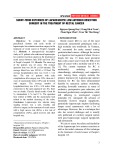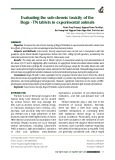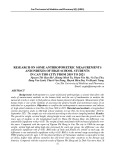
Can Tho Journal of Medicine and Pharmacy 9(6) (2023)
136
EX VIVO PERMEATION STUDY OF NANOSTRUCTURED DOSAGE
FORM CONTAINING MANGO SEED KERNEL EXTRACT USING
FRANZ CELL
Than Dang Tuyet Minh, Binh Thi Anh Thu, Le Tra My, Nguyen Huu Nhan,
Le Thi Thanh Yen, Nguyen Ngoc Nha Thao*
Can Tho University of Medicine and Pharmacy
*Corresponding author: nnnthao@ctump.edu.vn
Received: 13/8/2023
Reviewed:07/9/2023
Accepted: 05/10/2023
ABSTRACT
Background: mango seeds (Mangiferin indica L.) have the ability to inhibit P. acnes, S.
aureus, and E. coli bacteria and inhibit inflammation, potentially for transdermal therapeutic
dosage forms. The nano-emulsion dosage forms were prepared based on the SNEDDS system with
nano-oil droplets containing mango seed extract. These dosage forms contributed to carrying the
active ingredient deeply into the impact site, bringing the highest efficiency, but this needs to be
proven. Thus, it is necessary to study the process to evaluate the permeability of these formulas to
prove their availability improvement. Objectives: To assess the transdermal permeability and active
substance release of nanostructured dosage forms by a validated procedure. Methods: an ex vivo
experiment was designed by adding a sample to diffuse through Franz cells. In addition, to ensure
the quality and effectiveness of preparations containing mango seeds, developing and validating a
process for quantifying the total polyphenols in the preparation are extremely necessary. Total
polyphenols were quantified by color complexing with Folin-Ciocalteu reagents, with maximum
absorption at 765 nm. Results: the procedure had been validated according to the International
Conference on Harmonization (ICH) on the criteria of specificity, system compatibility with RSD =
1.02%, linearity built on the concentration range of 10–50 µg/ml with R2 = 0.998, accuracy,
precision with %recovery in the range of 97.73% to 102.56%. The results showed that more than
300 mg/g of polyphenol was released after 6 hours from the tested nanostructured dosage form,
about 4.3 times as many as the total amount of polyphenols in the comparative cream. Conclusions:
the quantification of polyphenols diffused through Franz cells helps evaluate the quality of the
preparation. The procedure had been validated according to the International Conference on
Harmonization (ICH) and could be applied to evaluate nanostructured dosage forms containing
mango seed kernel.
Keywords: mango seed kernel extract, Franz cell, polyphenols, nanostructured dosage forms.
I. INTRODUCTION
Mango’s scientific name is Mangifera indica L (M. indica) in the family Anacardiaceae.
Some studies in the world indicate that mango seeds have antioxidant effects applied to
protect food [1]; in addition, there are anti-inflammatory, antibacterial, and anti-fungal effects
applied to the digestive system, skin disease treatment, etc. [2], [3], [4], [5], [6]. According to
a study by Ha Cao Thien et al. (2022), mango seed kernel extract (MSKE) has significantly
better antibacterial and anti-inflammatory activity than mango seed coat extract [7]. On the
other hand, there has been no further research on biological activity or the application of these
activities to make preparations in Vietnam. In addition, we noticed that nowadays, a common
trend among consumers is using cosmetics made from natural medicinal herbs because of






![Study on toxicities of 10β-[(2'β-hydroxy-3'- imidazol) propyl] deoxo-artemisinin (32) in reproductive and developmental progresses of mice](https://cdn.tailieu.vn/images/document/thumbnail/2025/20250228/viinuzuka/135x160/8021740737116.jpg)

































